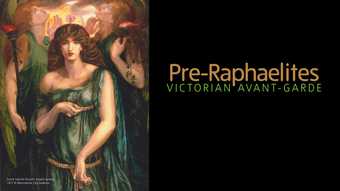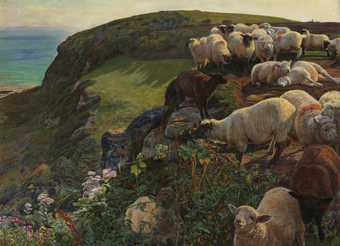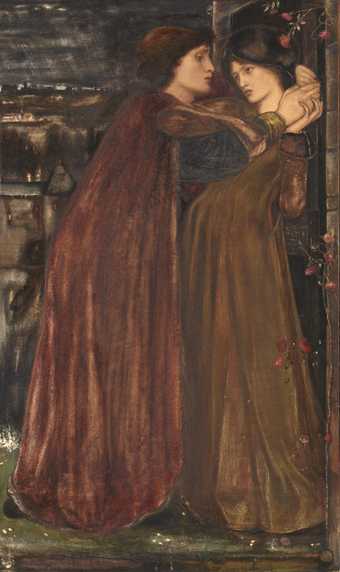I am working on a new biography of the Victorian artist and designer Edward Burne-Jones, and somehow this feels like precisely the right time. It is more than 30 years since the last full-length biography. Penelope Fitzgerald’s affectionate and subtle life of the artist was published in 1975, coinciding with the large Burne-Jones retrospective at the Hayward which began to re-establish his reputation after its many decades in the doldrums. Since then there have been the important 1997 exhibition at Tate Symbolism in Britain 1860–1910: The Age of Rossetti, Burne-Jones and Watts and the 1998 centenary show Edward Burne-Jones, Victorian Artist – Dreamer at the Metropolitan Museum of Art. Admiration for Burne-Jones no longer seems an aberration. He has been gradually emerging as the great figure of British art in the second half of the nineteenth century.
I am very often asked how I alight upon my subjects for biography. In a sense, I do not choose them. They are waiting there to claim me. Byron, Morris, Stanley Spencer, Eric Gill: always creative people of one sort or another, always subjects for whom I feel a deep affinity. I have loved Burne-Jones’s work ever since I saw King Cophetua and the Beggar Maid 1884 on a visit to Tate with my mother as a child of nine or ten. Later, in an exhibition in Sheffield, I came face to face with another of his wonderfully enigmatic compositions, The Golden Stairs 1880. I was already drawn into the thing so well described by his contemporary, George Du Maurier, as the “Burne-Jonesiness of Burne-Jones”. For me, biography is a process of unravelling, relating works of art to the lives and the social conditions that produced them. With his strange intensities, Burne-Jones was irresistible. Why did his works turn out the way they are?
I like the thundering mid-nineteenth century that he comes from, the great prophetic period of Ruskin and Carlyle. Ned Jones, as he was known before he became famous, was born in 1833 in Birmingham, where his father was a picture framer and gilder. He was brought up in a home of genteel poverty, aware of the extremes of social deprivation in the ruthlessly expansionist industrial city. Burne-Jones was of the second generation of Pre-Raphaelites, developing his talents at a time of intense activity in politics and art. The artist we know emerged at Oxford.
Ned entered Exeter College in 1853, where he was immediately enraptured by the ancient buildings and the dream quality of the medieval city, and found a convivial high minded group of friends. It was here that he met William Morris, an ebullient young man from a more prosperous background who was already writing poetry. Both were at that period intended for the priesthood, swept up in the Tractarian revolt against the age of materialism and empty moral values. After a traumatic crisis of faith, both decided instead to devote themselves to art: Morris to be an architect, Burne-Jones to be a painter. Religious faith was now transformed into the cult of beauty. The fight to bring art to all levels of society was seen by the young men as a solemn and a fierce one. Burne-Jones viewed himself and William Morris as “both Goths”.
Working on my earlier biography of Morris, the convergences between the two friends were instantly appealing: their shared love of storytelling, a hunger for narrative, especially the legends of King Arthur and the Holy Grail; the ease and sheer delight of their collaboration on designs for stained glass, mosaics, embroideries and tapestries, culminating in Burne-Jones’s illustrations for Morris’s Kelmscott Press. This was one of the greatest of artistic friendships, one enthusiasm sparking off another, and it lasted all their lives.
But as time went on it was the differences between them that fascinated me most. Not just the physical contrast of the fat man and the thin man, brought out in Burne-Jones’s brilliant caricatures of Morris bursting out of his waistcoats, shedding buttons, beside himself as the gloomy emaciated ghost. There was a fundamental divergence over politics, as Morris was propelled into political activism, founding his own revolutionary socialist party, the Socialist League. He chose an outdoor life of speech-making and demonstrating, visible and exposed, while Burne-Jones with equal moral seriousness worked away in his studio with “savage passion”, trusting his imagination as the mitigating factor between life as it was and life as it might be. What is an artist’s role, a public or a private one? This still unresolved dilemma put great pressure on their friendship, and it will be one of the main themes of my book.
The other prime artistic influence on Burne-Jones as a young man was Dante Gabriel Rossetti, painter and poet and charismatic co-founder of the Pre-Raphaelite Brotherhood. Rossetti nurtured the talent of an artist who he saw as a Victorian successor to Dürer in his delicacy and exactness of technique. In the 1860s Burne-Jones was drawn into alluring London artistic circles. From Rossetti he learned the concept of “the stunner”: a young woman of distinctive, rather outré beauty. The Pre-Raphaelite muse combined the qualities of dame lointaine (unattainable lady) with those of sexual siren. Burne-Jones was intensely susceptible to stunners. The depictions of women in many of his paintings are sweet-featured, golden haired, demure and graceful girlish figures. But there are also the temptresses: wild-eyed, flame-haired women who drag men to their destruction. Alarmingly, some of these demanding “Burne-Jones women”, as they came to be called, have fish-scaled mermaid tails.
John Ruskin saw his potential, gave him confidence and guidance, patronised him and his young wife Georgiana and paid for him to go to Italy. In 1859 he set out on the first of his four Italian journeys, travelling as far as Venice and Siena. In 1862 he and Georgie went with Ruskin to Milan and Venice so he could make copies of Italian Renaissance paintings. In 1871 he travelled further, on his own, to Pisa, Florence and south through Tuscany to Rome, where he lay on the floor of the Sistine Chapel studying the ceiling through opera glasses. “Now I care most for Michael Angelo, Luca Signorelli, Mantegna, Giotto, Botticelli, Andrea del Sarto, Paolo Uccello and Piero della Francesca,” he wrote when he returned. In 1873 he was in Italy again, this time with a more sceptical William Morris. The highly nervous Burne-Jones was ill on all these journeys, driven to unbearable pitches of excitement by the introduction to Renaissance art and architecture.
“I want big things to do and vast spaces, and for the common people to see them and say Oh! – only Oh!”
There is a radical ambitiousness about Burne-Jones which arose from his politics of art. The scale and scope of his work developed from his small beginnings as an illustrator of children’s fairy stories to the grandeur of his concepts in the 1870s and 1880s: the Perseus series, for example; the Briar Rose cycle; the mosaics for the American Episcopalian church St Paul’s-Within-the-Walls in Rome. It is not just that these works are large. Many other Victorian artists could do size. What marks out Burne-Jones was his visionary oddity, his quality of stillness – “That gift,” as one of his contemporaries expressed it, “of so strongly impressing the imagination and ever after haunting the memory.”
Burne-Jones’s final heroic undertaking was the 21ft painting The Sleep of King Arthur in Avalon. He had begun it in 1881 and still worked on it increasingly obsessively through the 1890s as his health deteriorated and his eyesight failed. It was a return to his old loyalty, the Arthurian legends which had enthralled him and Morris in their youth. Simultaneously, in the 1890s, Burne-Jones was designing the series of Holy Grail tapestries and costumes and sets for the Lyceum production of King Arthur with Henry Irving as Arthur and Ellen Terry as Guinevere. His melancholy pageant of a painting can be seen as alamentation for a nation he found increasingly jingoistic. By the time he finished Arthur, Britain was on the brink of the Boer War. It is also perhaps a hymn of grief for broken brotherhoods: the Pre-Raphaelites dead or scattered; the Morris & Co decorating partnership disbanded. And inescapably the painting bears a private inner meaning: Morris the King (as his friend always saw him) died of a diabetes-related illness in 1896; Burne-Jones himself died two years later, having been working on King Arthur in the studio until teatime on the day of his fatal heart attack. I have never seen this painting, which was purchased for the Museo de Arte de Ponce in Puerto Rico in 1963. I shall be one of the first to welcome its return on loan to Tate Britain in April. In reproduction it appears a prime example of the quality of belle inertie Burne-Jones shared with Gustave Moreau, a frozen moment of deep feeling, a weird and dreamlike distillation of grief. Was it this subsumed emotion which so impressed Picasso when he saw reproductions of his work in Barcelona in the 1890s that he planned a trip to England to see the real thing?
Burne-Jones’s influence on Picasso’s “Blue Period” paintings was clear to Wyndham Lewis, writing in 1940. He was certainly a painter who, while quintessentially Victorian, leads us forward to the psychological and sexual introspection of the early twentieth century.



